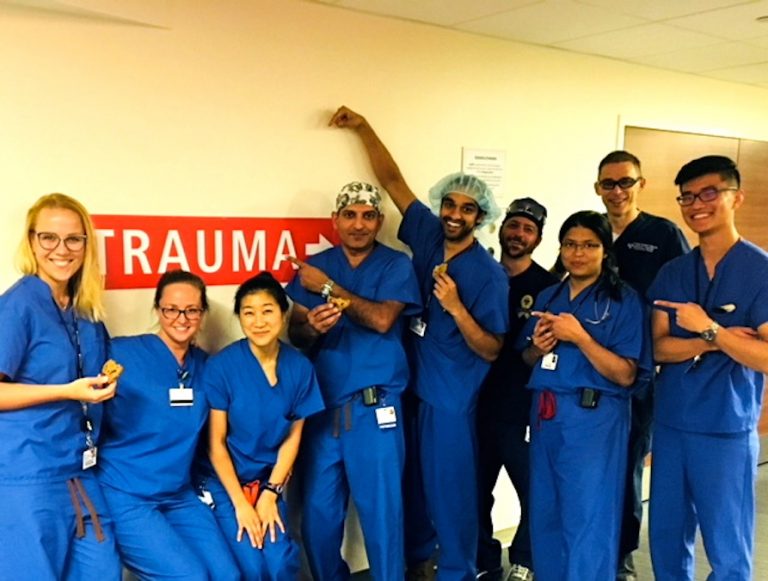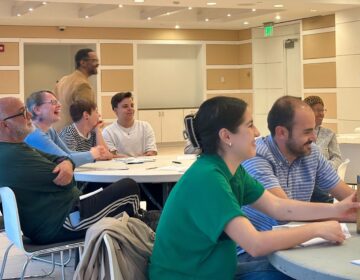Pa. hospitals rely on J-1 visas to fill vital roles, but fewer are applying
Among the 300,000 active visas, about 11,000 belong to medical residents who work and train in U.S. hospitals.
Listen 5:16
Second- year surgery resident Anna Mydlowska (far left) with her team of residents, attending physicians and nurses on the trauma unit at the Hospital of the University of Pennsylvania. (Courtesy of Anna Mydlowska)
J-1 visas are often used to bring young foreign workers to fill seasonal jobs at the Jersey Shore or at summer camps. But among the 300,000 active visas, about 11,000 belong to medical residents who work and train in U.S. hospitals.
Anna Mydlowska from Poland is in her second year of a seven-year surgery residency at the Hospital of the University of Pennsylvania. Working 24-hour shifts, she says often during the graveyard hours, she is the only person on the unit able to fill medication orders.
“Most of the nights you just go for 24 hours without sleeping,” said Mydlowska. “Your body is drained, but also this is why I think that people that end up in surgery and decided they want to be a surgeon. They are fully aware that this is life they’re going to have for the next seven years.”
Mydlowska is one of more than 1,000 medical residents on J-1 visas in Pennsylvania and New Jersey, who specialize in high-need areas, such as internal medicine and pediatrics. Out of all the surgical residents matched to U.S. hospitals in 2018, about 7 percent are on J-1 visas. But administrators worry that federal policies under the Trump administration, such as the proposal for “extreme vetting” of immigrants and travel bans, are hurting the program that fills gaps with high-performing trainees in the growing healthcare system.
The cream of the crop
Like other J-1 visa holders, Mydlowska is high achiever. She pursued a professional tennis career while graduating at the top of her class at Wake Forest University, and then attended medical school back home in Krakow, Poland. After earning top marks there, she applied to train as a medical resident through the J-1 visa program, and then was matched with Penn. She says back in Poland, the average age of surgeons is 55.
“And the U.S. does trauma surgery differently than the old-school European style taught there,” she said.
Surgery is No. 1 in her life. “The whole team is like a family,” she said.
But keeping up with her visa is a close second. “You are committing yourself to a lot of stress going through the entire J-1 process and some people don’t want to go through all of it. Even though they are exceptional, they decide to just stay in their home countries or go to Great Britain because it’s easier.”
Stacey Smith is the Vice Chair for Education at Lehigh Valley Health Network in Allentown. He says across the U.S., healthcare depends on international trainees like Mydlowska.
“Just as an example with internal medicine, we need probably 7,000 trainees in internal medicine each year — yet our medical schools only produce 18,000 graduates total for all the specialities. So there’s no way we can ever have enough people going to fill those spots,” said Smith. “So we rely probably on 50 percent of our spots being filled by international medical graduates.”
Smith says residents who are vetted through the J-1 program are especially nice for hospitals in hard-to-recruit areas like Allentown, which relies on about 60 new J-1 trainees a year. That’s not as many as Penn, but a relatively high percentage.
“In a way, it’s a luxury being able to take visa applicants because you’re able to cherry pick some of the most talented candidates from a multitude of different countries,” said Smith. “You can pick people with top board scores, top experiences, top skills that really actually add some really robust educational experience to our current training program.”
Mutual benefit through cultural exchange, interrupted
Unlike the H-1B program, the J-1 is not a work visa. It is a temporary cultural exchange program coordinated by the U.S. State Department and consulates around the world. For medical residents, the vetting process involves the CIA and a finance check, as well as a letter from the candidate’s home country saying it is in need of the specialty they will train in. The maximum stay is seven years.
One-quarter of all trainees working in U.S. hospitals went to medical school abroad. Similarly, 25 percent of all physicians working in this country were trained internationally. In some areas of medicine, including geriatrics and nephrology, these people make up more than half of the practicing physicians in their fields. Yet in the past year, hundreds fewer people applied for the J-1 program, according to data from the National Resident Matching Program.
William Pinsky is President of the Educational Commission for Foreign Medical Graduates, the agency that certifies J-1 visas for future doctors coming to the U.S. for training. He says it’s unclear how hospitals and medical facilities will fill those spots if the trend continues, and he believes the Trump administration’s immigration policies have weakened the program.
“The first travel ban opened up several cans of worms,” said Pinsky, whose agency is headquartered in West Philadelphia. “Decisions could be made, not understanding what the impact would be for health care.”
Smith says federal restrictions are affecting which applicants they select to work at Lehigh Valley Health Network.
“We’re looking over a lot of these applications because they come from countries where we know they’re going to have problems with immigration and we’re settling or choosing candidates that aren’t as talented,” said Smith.
Kimberly Cornwell manages Lehigh Valley’s J-1 visa program, and says some residents have had last-minute problems either securing all the necessary clearances, or traveling to the U.S.
“You’re not finding out until you’re already in the muck. And it feels like it’s an unnecessary stressor for these people where they’re trying to come in and just do their work, studying medicine to take care of people,” said Cornwell.
At Penn, Mydlowska’s surgical residency is a series of one-year contracts, which she says is common practice. This means she needs to go to Poland to renew her visa on summer breaks. She says even though she’s from a country that’s relatively easy immigration-wise, there is still a lot of uncertainty.
“They might say, ‘Sorry, we are not giving it to you this year.’ And you don’t really know if everything is going to happen on time and you’ll be able to come back and start your next year,” she explained. “I can’t even imagine how stressful it is for people who come from countries where there is active conflict.”
She says her goal is to further her training in trauma surgery by serving in the U.S. military — that is, if her time as a J-1 visa holder goes smoothly and she successfully applies for a different visa. But if it works out, she says all that extra paperwork would be worth it.
“I treat this country as my home,” said Mydlowska. “So knowing that in seven years, I’ll once again be going to pack my things and go back or somewhere else? It is a weird feeling to have in the back of my head.”
WHYY is your source for fact-based, in-depth journalism and information. As a nonprofit organization, we rely on financial support from readers like you. Please give today.




